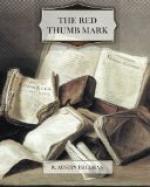“But, if not the prisoner’s thumb-print, what was it? The resemblance of the pattern was too exact for it to be the thumb-print of another person, for it reproduced not only the pattern of the ridges on the prisoner’s thumb, but also the scar of an old wound. The answer that I propose to this question is, that it was an intentional imitation of the prisoner’s thumb-print, made with the purpose of fixing suspicion on the prisoner, and so ensuring the safety of the actual criminal. Are there any facts which support this theory? Yes, there are several facts which support it very strongly.
“First, there are the facts that I have just mentioned. The red thumb-print disagreed with the genuine print in its scale or dimensions. It was not the prisoner’s thumb-print; but neither was it that of any other person. The only alternative is that it was a forgery.
“In the second place, that print was evidently made with the aid of certain appliances and materials, and one of those materials, namely defibrinated blood, was found in the safe.
“In the third place, there is the coincidence that the print was one which it was possible to forge. The prisoner has ten digits—eight fingers and two thumbs. But there were in existence actual prints of the two thumbs, whereas no prints of the fingers were in existence; hence it would have been impossible to forge a print of any of the fingers. So it happens that the red thumb-print resembled one of the two prints of which forgery was possible.
“In the fourth place, the red thumb-print reproduces an accidental peculiarity of the ‘Thumbograph’ print. Now, if the red thumb-print is a forgery, it must have been made from the ‘Thumbograph’ print, since there exists no other print from which it could have been made. Hence we have the striking fact that the red thumb-print is an exact replica—including accidental peculiarities—of the only print from which a forgery could have been made. The accidental S-shaped mark in the ‘Thumbograph’ print is accounted for by the condition of the paper; the occurrence of this mark in the red thumb-print is not accounted for by any peculiarity of the paper, and can be accounted for in no way, excepting by assuming the one to be a copy of the other. The conclusion is thus inevitable that the red thumb-print is a photo-mechanical reproduction of the ‘Thumbograph’ print.
“But there is yet another point. If the red thumb-print is a forgery reproduced from the ‘Thumbograph’ print, the forger must at some time have had access to the ‘Thumbograph.’ Now, you have heard Mrs. Hornby’s remarkable story of the mysterious disappearance of the ‘Thumbograph’ and its still more mysterious reappearance. That story can have left no doubt in your minds that some person had surreptitiously removed the ‘Thumbograph’ and, after an unknown interval, secretly replaced it. Thus the theory of forgery receives confirmation at every point, and is in agreement with every known fact; whereas the theory that the red thumb-print was a genuine thumb-print, is based upon a gratuitous assumption, and has not had a single fact advanced in its support.




